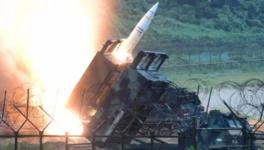Drones: Changing the Boundaries of War
Two successive UN Special Rapporteurs on extrajudicial killings, summary or arbitrary executions, have said that use of drones by the US for targeted killings violate international law. Christof Heyns, the current UN special rapporteur said in Geneva last week that the US drone warfare threatens the regime of international law built up over the last 50 years. At the conference, Heyn’s made clear that if the reports of the US’s policies of attacking first responders and funeral guests following an initial attack, are correct, this would indeed constitute a war crime.
There is little doubt that drone strikes have become the US’s preferred mode of waging war. From a scant 50 drones that the US possessed 10 years back, the drones with the US Air Force stands today at about 7,500. No new aircraft divisions are being created in the US, all the new divisions are drone divisions. More than 4,000 people have died in drone strikes in Pakistan alone. Afghanistan, Yemen, Somalia are the other countries in which drone strikes have been used. Killing are not only of “high value” targets but also through “signature strikes” – where people behaving in a particular way as seen from the drone cameras could then be killed even without a specific target being identified.
Though the US claims that the strikes are pinpointed and taken only after identification of the targets, the civilian casualties have been high, with 175 children dying in drone strikes in Pakistan alone. In spite of repeated questions by the previous UN Special Rapporteur Philip Alston and the current one, Christof Heyns, the US has not disclosed what this alleged “process” is and how can signature strikes satisfy such a process, where targets are not even identified.
What are drones? Drones are unmanned aerial vehicles that can fly for long periods, carry cameras to transmit pictures of what is being observed on the ground to its “pilot” sitting somewhere else and carries missiles and even “smart” bombs for strikes on the ground. The pilots can sit in a remote location, as far away as Nevada and carry out strikes anywhere in the world. While drone strikes are carried out by drones carrying weapons, there are also other drones, the more well-known ones being surveillance drones that are used either in monitoring borders, cities, etc., and of course in old fashioned spying over other countries. It is one of these spy drones that Iran captured a few months back, leaving red faces in the US.
The two of the most well-known drones are the Predators and Reapers. The Predator drones are the first mass produced drones inducted in the US Armed Forces. They can hover over targets for about half a day and carry “Hellfire” missiles. The Reapers are the later version, can hover over target areas for 2-3 days at 50,000 feet and carry, apart from the Hellfire missiles, also laser guided 500 lb bombs. One of the arguments that drones carry out surgical strikes is of course automatically negated if a couple of 500 lb bombs are also used. Nobody has accused 500 lb bombs of being surgical. Neither is there a difference between such bombs being dropped from manned aircraft or unmanned drones.
What makes drones particularly attractive for the US and its imperial project is that it then does not have to put boots on the ground. Unlike Vietnam, the Iraq occupation has had a far lower casualty of the US occupying forces. Of course not for the Iraqis, who continue to die in large numbers, just as the Vietnamese did. What makes war acceptable in the US is the absence of body bags. The drones are therefore ideal for the US – it promises no loss of US lives. It also provides the US soldiers carrying out drone strike in distant lands all the home comforts; after spending a gruelling day in the field -- in an air-conditioned cabin in Lake Creech, Nevada bombing villages in Afghanistan or Yemen -- the “soldier” can go back to his family in the evening.
What makes the evolving drone scenario particularly dangerous is that drones are no longer hi-tech high capital intensive toys that only the advanced countries can build. The entire avionics, or large portions of it are the same in any of the newer mobile phones. The key sensors that help to fly the drones – the gyroscope, accelerometers, the GPS system – are shared with any mobile phone today. The same electronics that turns the image around every time you turn the mobile phone around is also the key to flying the drones. A huge new industry of hobby drones has sprung up, and advance-by-advance, they match the crucial technology inside the military drones. In other words, any country that today wants to make or use drones, can invest a small amount in the avionics or buy them off-the-shelf and design a larger unmanned vehicle around it. They will have a drone every bit as sophisticated as the ones the US is flying today. The aircraft is not the issue, the electronics flying it is and that is the one that our cell phones share with the drones.
This brings us to the other intertwined question on drones – International Humanitarian Law and of course Law of War as codified by the various Geneva Conventions and accepted by all the parties. It is clear that targeted assassinations are illegal – this is the law accepted by all countries and is the reason that even Hilary Clinton publicly condemned the assassination of Iranian scientists carried out by sticky bombs attached to their cars. Publicly, it is only Israel that has a declared policy of targeted assassinations.
The US position that it is carrying extra judicial killings that are not assassinations. These extra judicial killings are permitted – according to the US – as it is in a worldwide war against al Qaeda and Taliban. In their view, in self defence, they have the right to attack anybody, anywhere using lethal force. The only process they need to follow is an undisclosed one supposedly carried out within the confines of the US Government before such a strike.
No, this is not a caricature of the position. This is what officials of the US Administration have been saying over and over again. It started with Harold Koh, Legal Adviser to the U.S. Department of State saying this in the Annual Meeting of the American Society of International Law in Washington, DC, in March, 2010 and has been the public position various officials have taken since then, the latest being Defence Secretary Leon Panatta in New Delhi last month. He claimed that strikes in FATA, Pakistan are justified even without Pakistan’s permission as it is question US sovereignty too; the US has a sovereign right to bomb any country to “protect its citizens”. Of course if the same right is exercised by Cuba against terrorists in the US who have blown up Cuban civilian aircraft and killed Cubans in terror attacks, we all know what will happen. Or if Iran also uses cyber weapons against the US as it has used against Iran.
With such a due process, funerals and weddings have been attacked in Afghanistan and Pakistan, which obviously have a large number of civilians. Even schools have been attacked killing a large number of children. A number of strikes have also been carried out when people have gone to rescue people after an initial strike; strikes which the UN rapporteur says are likely to be war crimes. All those killed should be happy that the US has killed only after following a due process and that makes it perfectly “legal”.
A US, a debate is also on whether US citizens can be killed this way without a “due process of law” as guaranteed under the constitution. The Obama administration’s answer is that a due process of law is not necessarily a judicial process – as long as the US Government has carried out “a process”, the constitutional guarantee of due process is satisfied.
The danger is that drones are now too easy to make. So what happens if 50 countries start using drones? What happens if they use the same logic and use it outside their territory? Does the laws of war change if drones are used instead of conventional weapons?
What the US has done is that it has used new technology of drones and cyber war to blur the distinction that existed in International Law of what is legitimate and what is not. It has overridden both Laws of War and International Humanitarian Law. In doing so, it justifies targeted killings provided it is the one carrying out such killings, while condemning it for others. It has made double standards into an official position – it has imperial privileges that no other country can have.
David Sanger in his new book Confront and Conceal: Obama's Secret Wars and Surprising Use of American Power makes it clear that President Obama was fully involved in the drone war as he was with the cyber war. The drone wars are not an aberration of a particular US Administration; it is now the declared policy of two successive US Presidents.
Heyns stated the challenge of using drone succinctly, “My concern is that we are dealing here with a situation that creates precedence around the world. Not only for one particular country, for one particular administration, but this is technology that develops very fast and its almost as if there’s a genie that's about to come out of a bottle and unless the international community focuses on this, and not only this particular country but I think across the board, to establish and re-establish the legal framework within which this takes place. I think we're in for very dangerous precedents that can be used by countries on all sides”.
We will either have a free for all or a dual regime where only the US is allowed to use outside its borders. A regime similar to the nuclear ones where nuclear weapons are legal for one set of countries while being illegal for others. The problem is that even with nuclear weapons, this regime is not working. It is unlikely to work with drones too as the technology is even easier.
Get the latest reports & analysis with people's perspective on Protests, movements & deep analytical videos, discussions of the current affairs in your Telegram app. Subscribe to NewsClick's Telegram channel & get Real-Time updates on stories, as they get published on our website.
























